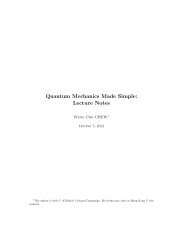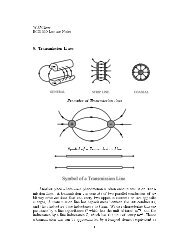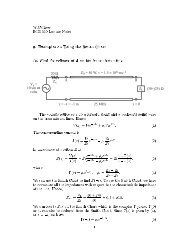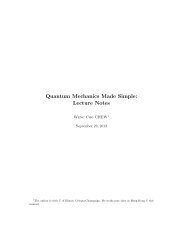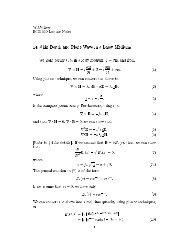7. The Smith Chart
7. The Smith Chart
7. The Smith Chart
Create successful ePaper yourself
Turn your PDF publications into a flip-book with our unique Google optimized e-Paper software.
W.C.Chew<br />
ECE 350 Lecture Notes<br />
<strong>7.</strong> <strong>The</strong> <strong>Smith</strong> <strong>Chart</strong><br />
We have seen from Equation (6.9) that a generalized impedance can be<br />
dened as<br />
V<br />
Z(z) = ~ (z)<br />
~I(z) = Z e ;jz + v e +jz<br />
0<br />
e ;jz ; v e<br />
+jz:<br />
(1)<br />
<strong>The</strong> above can be written as<br />
1+ v e 2jz<br />
Z(z) =Z 0<br />
1 ; v e = Z 1+;(z)<br />
2jz 0<br />
1 ; ;(z) (2)<br />
where ;(z) is as dened in (6.16). When z = 0, Z(0) = Z L , and ;(0) = v ,<br />
and (2) becomes (6.25). Hence (6.25) is a special case of (2). We can introduce<br />
a normalized generalized impedance to be<br />
Similarly,<br />
Z n (z) = Z(z)<br />
Z 0<br />
= 1+;(z)<br />
1 ; ;(z) : (3)<br />
;(z) = Z n(z) ; 1<br />
Z n (z)+1 : (4)<br />
Given ;(z), we can solve for Z n (z) in (3), and given Z n (z), we can solve for<br />
;(z) in (4). It turns out that the mapping of Z n (z) to;(z) and the mapping<br />
of ;(z) toZ n (z) are one-to-one. We shall next discuss a graphical method to<br />
solve (3) and (4) rapidly using the <strong>Smith</strong> <strong>Chart</strong>.<br />
X n<br />
Z n = R n + jX n<br />
R n = .5 R n = 1 R n = 2<br />
Im Γ<br />
X n = 1<br />
1<br />
X n = 1<br />
R n = 0<br />
R n = 1<br />
R n = .5<br />
R n = 2<br />
R n = 0<br />
0 0.5 1 2<br />
X n = 0<br />
R n<br />
0 0.5 1 2<br />
Re Γ<br />
–1<br />
X n = –1<br />
|Γ| = 1<br />
circle<br />
X n = –1<br />
Z n – plane<br />
Γ–plane<br />
Z n is a complex number and can be represented by a point on the Z n -plane,<br />
and ; is a complex number and can be represented by apoint on the complex<br />
; plane.<br />
1
We noted that from Equation (4) that:<br />
(i) When Z n =0 ;=;1.<br />
(ii) When Z n =1,or R n =1X n =0 ;=0.<br />
(iii) When Z n !1in any direction, ; ! 1.<br />
(iv) When Z n = jX n j;j =1.<br />
(v) When Z n = j, or R n =0X n =1 ;=j.<br />
(vi) When Z n = ;j, or R n =0X n = ;1 ;=;j.<br />
If one works out the mapping from Z n -plane to ;-plane completely, one<br />
nds that the R n = 0 line on Z n -plane maps onto the unit-circle on the ;-<br />
plane. Furthermore, the other R n = constant lines map into circles as shown.<br />
<strong>The</strong> X n = constant lines map into arcs like the X n 1 lines as shown. Hence,<br />
if one puts grids on the ;-plane, one can read o the R n and X n associated<br />
with the corresponding ; immediately, and, given the value of ;, one can<br />
read o the values of R n and X n immediately.<br />
<strong>The</strong> mappings (3) and (4) are known as bilinear transforms. A bilinear<br />
transform always maps a circle onto a circle.<br />
Properties of a <strong>Smith</strong> <strong>Chart</strong><br />
(i) <strong>The</strong> normalized admittance Y n = 1=Z n , or the reciprocal of Z n , can be<br />
found easily from a <strong>Smith</strong> <strong>Chart</strong>, because<br />
Zn<br />
;= Z n ; 1<br />
Z n +1 = 1 ; 1<br />
1+ 1<br />
Zn<br />
= 1 ; Y n<br />
1+Y n<br />
= ; Y n ; 1<br />
Y n +1 : (5)<br />
(ii) <strong>The</strong> change of impedance along the line is obtained by adding or subtracting<br />
phase to ;(z) via the relationship<br />
;(z) = v e 2jz : (6)<br />
(iii)<br />
VSWR = 1+j vj<br />
1; j v j = R nmax (7)<br />
since the <strong>Smith</strong> <strong>Chart</strong> is a graphical tool to solve Equation (7), and j v j<br />
is real, corresponding to a number on the X n = 0 line. Notice that<br />
1 < VSWR < 1 always.<br />
2



